Water logic
By Edward de Bono (includes links to many of his other books)
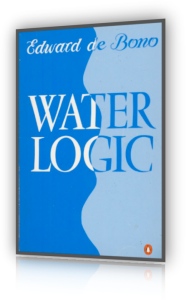
Amazon link: Water logic

Water Logic Explored
Contents

At several points in the book I have referred to ‘water logic’ as a contrast to the ‘rock logic’ of traditional thinking.
The purpose of this naming of ‘water logic’ is to give an impression of the difference.
At this point I shall spell out in more detail some of the points of difference.
A rock is solid, permanent and hard.
This suggests the absolutes of traditional thinking (solid as a rock).
Water is just as real as a rock but it is not solid or hard.
The permanence of water is not defined by its shape.
A rock has hard edges and a definite shape.
This suggests the defined categories of traditional thinking.
We judge whether something fits that category shape or not.
Water has a boundary and an edge which is just as definite as the edge of a rock, but this boundary will vary according to the terrain.
Water will fill a bowl or a lake.
It adapts to the terrain or landscape.
Water logic is determined by the conditions and circumstances.
The shape of the rock remains the same no matter what the terrain might be.
If you place a small rock in a bowl, it will retain its shape and make no concession at all towards filling the bowl.
The absolutes of traditional thinking deliberately set out to be circumstance-independent.
If you add more water to water, the new water becomes part of the whole.
If you add a rock to a rock, you simply have two rocks.
This addition and absorption of water logic corresponds to the process of poetry, in which new images become absorbed in the whole.
It is also the basis of the new artificial device of the ‘strata!’.
With conditions and circumstances, the addition of new circumstances becomes part of the whole set of circumstances.
We can match rocks by saying this shape ‘is’ or ‘is not’ the same as another shape.
A rock has a fixed identity.
Water flows according to the gradient.
Instead of the word ‘is’ we use the word ‘to’.
Water flows ‘to’ somewhere.
In traditional (rock) logic we have judgements based upon right/wrong.
In perception (water) logic we have the concepts of ‘fit’ and ‘flow’.
The concept of ‘fit’ means:
‘Does this fit the circumstances and conditions?’
The concept of ‘flow’ means:
‘Is the terrain suitable for flow to take place in this direction?’
Fit and flow both mean the same thing.
Fit covers the static situation, flow covers the dynamic situation.
Does the water fit the lake or hole?
Does the river flow in this direction?
Truth is a particular constellation of circumstances with a particular outcome.
In this definition of truth we have both the concepts of fit (constellation of circumstances) and of flow (outcome).
In a conflict situation both sides are arguing that they are right.
This they can show logically.
Traditional thinking would seek to discover which party was really ‘right’.
Water logic would acknowledge that both parties were right but that each conclusion was based on a particular aspect of the situation, particular circumstances, and a particular point of view.
‘TO’
What do we mean by ‘to’?
A ball on a slope rolls ‘to’ or towards the bottom of the slope.
A river flows ‘to’ the sea.
A path leads ‘to’ some place.
An egg in a frying-pan changes ‘to’ a fried egg.
A falling egg leads ‘to’ the mess of a broken egg on the carpet.
A film director may cut from a shot of a falling egg ‘to’ a shot of a collapsing tower.
A film director may cut from a shot of a falling egg ‘to’ a shot of an anguished girl.
A ball that rolls ‘to’ a new position is still the same ball.
The raw egg that becomes the fried egg is still the same egg in a different form.
But the shot of the collapsing tower or the anguished girl in the film is only related to the prior shot of the falling egg because the director has chosen to relate them.
So we really use ‘to’ in a number of different ways.
Throughout this book I intend to use ‘to’ in a very simple and clear sense:
what does this lead to?
What happens next?
It simply means what happens next in time.
If a film image of an egg is followed by the image of an elephant then the egg leads to the elephant.
If you are being driven in a car along a scenic route and an idyllic shot of a cottage is followed by a view of a power station, then that is what happens next.
So the sense of ‘to’ is not limited to ‘becoming’ or ‘changing to’, although this will also be included in the very broad definition of ‘to’ as what happens next.
An unstable system can become a stable system.
A stable system can become an unstable system.
One thing leads to another.
Because this notion of ‘to’ is so very important it would be useful to define it precisely with a new word.
Perhaps we could create a new preposition, ‘leto’, to indicate ‘leads to’.
At this point in time it would sound only artificial and unnecessary

1. FOREWORD
Johnny was a young boy who lived in Australia.
One day his friends offered him a choice between a one dollar coin and a two dollar coin.
In Australia the one dollar coin is considerably larger than the two dollar coin.
Johnny took the one dollar coin.
His friends giggled and laughed and reckoned Johnny very stupid because he did not yet know that the smaller coin was worth twice as much as the bigger coin.
Whenever they wanted to demonstrate Johnny’s stupidity they would repeat the exercise.
Johnny never seemed to learn.
One day a bystander felt sorry for Johnny and beckoning him over, the bystander explained that the smaller coin was actually worth twice as much as the larger coin.
Johnny listened politely, then he said: ‘Yes, I do know that.
But how many times would they have offered me the coins if I had taken the two dollar coin the first time?’
A computer which has been programmed to select value would have had to choose the two dollar coin the first time around.
It was Johnny’s human ‘perception’ that allowed him to take a different and longer-term view: the possibility of repeat business, the possibility of several more one dollar coins.
Of course, it was a risk and the perception was very complex: how often would he see his friends?
Would they go on using the same game?
Would they want to go on losing one dollar coins, etc.?
There are two points about this story which are relevant to this book.
The first point is the great importance of human perception, and that is what this book is about.
Perception is rather different from our traditional concept of logic.
The second point arising from the story is the difference between the thinking of Johnny and the thinking of the computer.
The thinking of the computer would be based on ‘is’.
The computer would say to itself:
‘Which of the two coins “is” the most valuable?’
As a result the computer would choose the smaller, two dollar coin.
The thinking of Johnny was not based on ‘is’ but on ‘to’:
‘What will this lead to?’
‘What will happen if I take the one dollar coin?’
Traditional rock logic is based on ‘is’.
The logic of perception is water logic and this is based on ‘to’.
The basic theme of the book is astonishingly simple.
In fact it is so simple that many people will find it hard to understand.
Such people feel that things ought to be complex in order to be serious.
Yet most complex matters turn out to be very simple once they are understood (here, here, and here).
Because the theme is so simple I shall attempt to describe it as simply as possible.
Although the basic theme is simple the effects are powerful, important and complex.
I have always been interested in practical outcomes. (Find practical outcomes here)
There are many practical processes, techniques and outcomes covered in this book.
How would you like to ‘see’ your thinking as clearly as you might see a landscape from an aeroplane?
There is a way of doing that which I shall describe.
This can be of great help in understanding our perceptions and even in altering them.
I know that my books attract different sorts of readers.
There are those who are genuinely interested in the long neglected subject of thinking and there are those who are only interested in practical ‘hands-on’ techniques.
The latter type of reader may be impatient with the underlying theory, which is seen to be complex and unnecessary.
I would like to be able to say to this sort of reader: ‘Skip section ...
and section ...’
But I will not do that because thinking has suffered far too much from a string of gimmicks that have no foundation.
It is very important to understand the theoretical basis in order to use the processes with real motivation.
Furthermore the underlying processes are fascinating in themselves.
Understanding how the brain works is a subject of great interest.
I have used no mathematical expressions in the book because it is a mistake to believe that mathematics (the behaviour of relationships and processes within a defined universe) has to be expressed in mathematical symbols which most people do not understand.
Some years ago Professor Murray Gell-Mann, the California Institute of Technology professor who won a Nobel prize in physics for inventing/discovering/describing the quark, was given my book The Mechanism of Mind which was published in 1969.
He told me that he had found it very interesting because I had ‘stumbled upon processes ten years before the mathematicians had started to describe them’.
These are the processes of self-organizing systems which interested him for his work on chaos —try an Amazon search.
This book is a first look at water logic and my intention has been to put forward a method for using it in a practical manner.

2. INTRODUCTION
This book is closely related to my previous book I am Right - You are Wrong (London: Viking, 1990 and Penguin 1991).
In that book I set out to show that the traditional habits of Western thinking were inadequate and how our belief in their adequacy was both limiting and dangerous.
These traditional habits include: the critical search for the ‘truth’; argument and adversarial exploration, and all the characteristics of rock logic with its crudities and harshness.
These habits of thinking were ultimately derived from the classic Greek gang of three, Socrates, Plato and Aristotle, who hijacked Western thinking.
After the dogma of the Dark Ages, the rediscovery of this classical thinking was indeed a breath of fresh air and so these habits were taken up both by the Church (to provide a weapon for attacking heresy) and by the non-Church humanist thinkers to provide an escape from Church dogma.
So it became the established thinking of Western civilization.
Unfortunately this thinking lacks the creative, design and constructive energies that we so badly need.
Nor does this thinking take into account the huge importance of perception, beliefs and local truths.
Finally this rock logic exacerbates the worst deficiencies of the human brain, which is why we have made progress in technical matters and so little in human affairs.
For the first time in history we do know something, in broad terms, about how the brain works as a self-organizing information system - and this has important implications.
As I predicted the book was met with outrage that was so hysterical that it became comic and ludicrous rather than offensive.
Not one of those who attacked the book ever challenged its basic themes.
The attacks were in the nature of childish personal abuse or picked on very minor matters - which is always a sure indication that the reviewer is not reviewing the book but prefers to attack the author.
This is a pity because it is a serious subject which needs much more attention than it gets.
It was Einstein who once said: ‘Great spirits have always encountered violent opposition from mediocre minds.’
It does not follow that violent opposition from mediocre minds qualifies one automatically as a great spirit but it does suggest that the violence of the opposition sometimes indicates emotions rather than value.
To redress this balance, because the subject is important, I invited three Nobel prize physicists to write forewords to the book for future editions.
Those forewords put the matter into perspective.
Why physicists?
Because physicists spend their whole lives looking at fundamental processes and their implications.
I had intended to add a section on water logic and ‘hodics’ to the book.
In the end the book became too long and it was obvious that the section would have to be too short to do justice to the subject.
I promised I would treat the subject in a subsequent publication, and that is what this book is about.
In our tradition of thinking we have sought to get away from the vagueness and instability of perception in order to deal with such concrete matters as mathematics and logic.
We have done reasonably well at this and can now get back to dealing with perception as such.
Indeed we have no choice because if our perceptions are faulty then perfect processing of those faulty perceptions can only give an answer that is wrong, and sometimes dangerous.
We know from experience that both sides in any war, conflict or disagreement always have ‘logic’ on their side.
This is true: a logic that serves their particular perceptions.
So this book is about the water logic of perception.
How do perceptions come about?
What is the origin and nature of perception?
How do the nerve circuits in the brain form and use perceptions?
How do perceptions become stable - and stable enough to become beliefs?
Can we get to look at our perceptions regarding any particular matter?
Can we change perceptions—and if so, where do we start?
This book does not provide all the answers but at the end of it the reader should have a good understanding of the difference between water logic and rock logic. …

Choosing a holiday base list
A COST → I
B CLIMATE → Q
C LOW HASSLE → Q
D GOOD COMPANY → G
E ACTIVITIES → T
F SIGHTSEEING → E
C RELAXING → T
H SOMETHING TO TALK ABOUT → R
I AGREEMENT OF ALL PARTIES → H
J EXPERIENCE → K
K PRIOR KNOWLEDGE → E
L TOLERANCE → O
M PLAN AHEAD → P
N ADVICE → K
0 RISK → A
P TIME OF YEAR → B
Q INTERESTS → G
R ANTICIPATION → Q
S HEALTH → T
T ENERGY → Q
Choosing a holiday flowscape
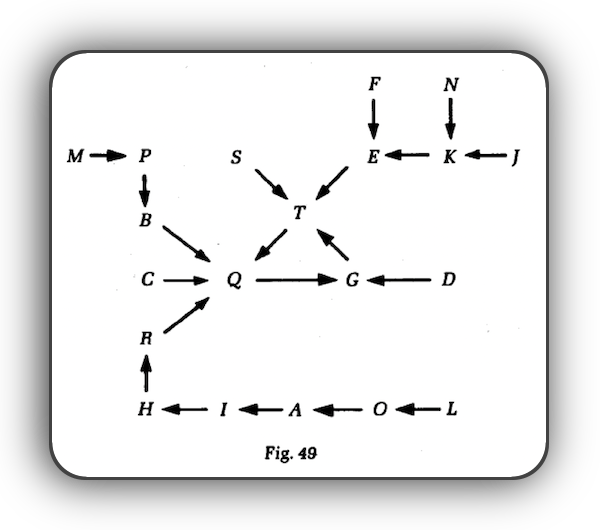
See Peter Drucker's From Analysis to Perception—The New Worldview and The Educated Person for relevance connections. Chapters on these topics can be found in several of Drucker's books. Both can be found in The Essential Drucker.

3. Structure of the book
I start by considering the importance of perception which is the working of the inner world of the mind.
This is different from the outer world which surrounds us.
Traditionally we have tried to get away from perception to deal with the ‘truth’ of reality.
It is time we looked directly at perception.
The next section introduces the notion of water logic and ‘flow’.
Traditional logic is rock logic and is based on ‘is’ and identity.
Water logic is based on ‘to’: what does this flow to?
An analogy involving the behavior of simple jellyfish then illustrates how ‘flow’ works to give stability in a self-organizing system.
Different flow patterns are illustrated.
There is now a direct consideration of the ‘flow behavior’ of the brain and how this gives rise to perception.
The jellyfish analogy is transferred to the behavior of nerve circuits in the brain but the principles remain the same.
A practical technique called the ‘flowscape’ is now introduced.
This technique enables us to see the ‘shape’ of our perceptions.
I explain how flowscapes are created.
A stream of consciousness provides the items for the ‘base list’ from which the flowscape is derived.
The nature of this list is discussed.
There follows a consideration of flowscapes that are more complex, with comments upon these.
The next section deals with the great importance of concepts in water logic and in perception.
Concepts give us flexibility and movement in thinking.
These concepts do not need to be precise and a little fuzziness is beneficial.
We may want to see how we might intervene to alter perceptions.
This section is concerned with methods of intervention based on the flowscape.
Although the flowscapes are concerned with the inner world of perception, we can derive from the flowscapes some strategies for dealing with the outer world.
The notion of context is central to water logic because if the context changes then the flow direction may also change.
This is very different from the assumed absolutes of rock logic.
Being based on perception, flowscapes are highly personal.
Nevertheless, it is possible to attempt to chart the perceptions of others.
This can be done in a number of ways ranging from discussion to guessing.
Even guessing can suggest usable strategies.
The flow of our attention over the outer world is strongly influenced by the perceptual patterns we have set up in the inner world.
This is considered in this section as is the relationship between art and attention flows.
The practical difficulties that might be encountered in setting up flowscapes are now considered with some suggestions as to how they might be overcome.
The summary pulls together the nature of water logic and the practical technique of the flowscape.
Water logic does not exist only as a contrast to rock logic.
Edward de Bono
Palazzo Marnisi
Malta

4. Outer world — inner world
The original title of this section was going to be ‘Perception and Reality’.
In the traditional way this would have suggested that there was reality ‘somewhere out there’ and then there was perception which was different from reality.
But perception is just as real as anything else — in fact perception is more real for the person involved.
A child’s terror at a moving curtain in the night is very real.
A schizophrenic’s anguish at inner voices is very real.
In fact, perception is the only reality for the person involved.
It is not usually a shared reality and may not check with the world out there, but perception is certainly real.
From Analysis to Perception
For centuries Western thinking has been dominated by the analogy of Plato’s cave in which a person chained so that he can only see the back of the cave, sees only the shadows projected on this surface and not the ‘reality’ that has caused the shadows.
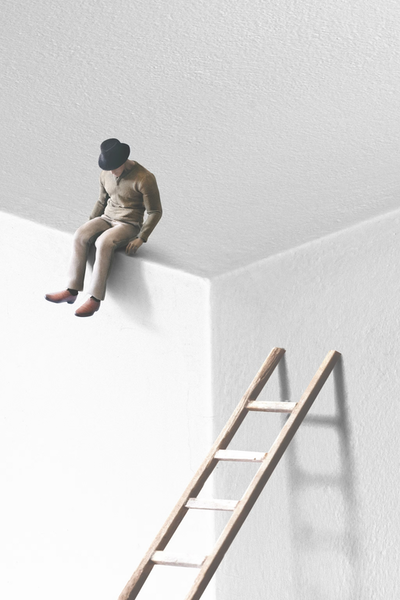
So philosophers have generally looked for the ‘truth’ that gives rise to these shadows or perceptions.
It is quite true that some people, like Freud and Jung in particular, focused their attention on the shadows, but not on perception in general.
This lack of interest in perception is understandable.
People wanted to get away from the messiness of perception to the solidity of truth.
More importantly, you cannot do much except describe perceptions unless you have some understanding of how they work.
That understanding we have come to only very recently.
A Georgian manor house is set on its own in the fields.
A party of people arrive for the weekend.
They are all looking at the same house.
One person looks at it with nostalgia for happy times spent there.
Another person looks at it with envy, thinking of the sort of life style she would want.
A third person looks at it with horror, remembering a harsh childhood spent in the house.
A fourth person immediately assesses how much such a house would cost.
The house is the same in each case and a photograph taken by each of the people would show the same house.
But the inner world of perception is totally different.
In the case of the house seen differently the physical view is the same but the memory trails and emotional attachments provide the different inner world of perception.
But perception could still be different even if there were no special memory trails.
If each of the guests were to approach the house from a different direction they would get a different point of view.
It would be the same house perceived from a different perspective.
The person approaching from the front would get the classic Georgian facade.
A person approaching from the side would see the original Elizabethan house on to which the facade had been tacked.
The person approaching from the back might mistake the house for a farm.
Everyone knows of the classic optical illusions in which you look at a drawing on a piece of paper and what you think you see is not actually the case: lines which seem to bend but are actually straight; a shape that looks larger than another but is exactly equal.

Stage magicians perform the magnificent feat of fooling all the people all the time through tricking their perceptions.
We are left waiting for the event to occur while it has occurred a long time before.
It is obvious that perception is very individual and that perception may not correspond with the external world.
Perception, in the first place, is the way the brain organizes the information received from the outer world via the senses.
The type of organization that is possible depends entirely on the fundamental nature of the nerve circuits in the brain.
This organization is then affected by the emotional state of the moment which favors some patterns at the expense of others.
The short-term memory of the present context and what has gone immediately before affects perception.
Computer translation of language is so difficult because what has gone before, and the context, may totally alter the meaning of the word.
For example, the word ‘live’ is pronounced in two different ways depending on the context.
Finally there are the old memories and memory trails which can both alter what we perceive and attach themselves to the perception.
One of the most striking examples of the power of perception is the phenomenon of jealousy.
A man is accused of choosing to sit in a certain place in a restaurant so that he can stare at the blonde sitting opposite.
In truth, he had not even noticed the blonde and was really trying to give his girlfriend the seat with the best view.
A wife seems to be seeing a lot of a certain man in the course of her business.
She claims it is a business relationship but her husband thinks otherwise.
In jealousy there are complex interpretations of normal situations which may be totally false and yet give rise to powerful emotions, quarrels and violence.
The point is that the perceptions could, just possibly, be true.
The fact that they are not true does not alter the perceptions.
It is no wonder that the ancient thinkers considered it a magnificent feat to get away from this highly subjective business of perception to truths and absolutes which could be checked and which would hold for everyone.
If you were making a table you could guess the sizes of the pieces that you needed and just cut them up according to your guess.
You would probably be better off if you were to measure the pieces you needed.
They would then be more likely to fit together and the table legs would be the same height.
Measurement is a very successful way of changing perception into something that is concrete, tangible and permanent.
We take it for granted but it is a wonderful concept.
Mathematics is another method for escaping the uncertainties of perception.
We translate the world into symbols and relationships.
Once this is done we enter the ‘game world’ of mathematics with its own special universe and rules of behavior within that universe.
We play that game in a rigorous manner.
Then we translate the result back into the real world.
The method works very well indeed provided the mathematics is appropriate and the translation into and out of the system is valid.
The great contribution of the Greek gang of three was to set out to do the same thing with language.
Words were going to have specific definitions and to be as real, concrete and objective as is measurement.
Then there was going to be a rigorous game with rules which would tell us how to put words together and how to reason.
This game was largely based on identity: this thing ‘is’ or ‘is not’ something else.
The principle of contradiction held that something could not ‘be’ and ‘not be’ something at the same time.
From this basis we developed our systems of language, logic, argument, critical thinking and all the other habits which we use all the time.
The result was that we seemed able to make judgements (which the human brain loves) and to arrive at truths and certainties.
This was all very attractive and it was very successful when applied to technical matters.
It seemed successful when applied to human affairs because judgement and certainty gave a basis for action and for righteousness.
In fact this habit of ‘logic’ is no less a belief system than any other.
If you choose to look at the world in a certain way then you will reinforce your belief by seeing the world in that way.
So the trend has been to flee the world of perception in terms of thinking and to leave perception to art which could explore and elaborate perceptions at will.
I believe it is time we did turn our attention to the world of perception in order to understand what actually happens in that world.
The world of perception is closely related to the way the brain handles information and that is what I explore in the book I am Right - You are Wrong.
There is no ‘game truth’ in perception as there is in mathematics where something is true because it follows from the rules of the game and the universe.
All truth in perception is either circular or provisional.
Circular truth is like two people each telling the other that he or she is telling the truth.
Provisional truth is based on experience:
‘it seems to me’;
‘as far as I can see’;
‘in my experience’.
There is none of that wonderful certainty which we have with ordinary logic — which is a ‘belief truth’ that masquerades as a ‘game truth’.
In the inner world of perception there is not the solidity and permanence of ‘rock logic’.
A rock is hard, definite and permanent, and does not shift.
This is the logic of ‘is’.
Instead, perception is based on water logic.
Water flows.
Water is not definite and hard edged but can adapt to its container.
Water logic is based on ‘to’.
The purpose of this book is to explore the nature and behavior of water logic and to demonstrate some practical ways of using it.
Water logic is the logic of the inner world of perception.
I suspect that it also applies, far more than we have hitherto thought, to the external world as well.
As we start to examine self-organizing systems, as mathematics begins to look into non-linear systems and chaos, so we shall find that water logic is also relevant to many aspects of the external world to which we have always applied rock logic.
I believe this to be the case with economics.
There is a direct impact of perception and water logic even on the apparent rock logic of science.
The mind can see only what it is prepared to see.
The analysis of data does not, by itself, produce ideas.
The analysis of data can only allow us to select from existing ideas.
There is a growing emphasis on the importance of hypotheses, speculation, provocation and model building, all of which allow us to see the world differently.
The creation of these frameworks of possibility is a perceptual process.
I should add that there is no such thing as a contradiction in perception.
Opposing views may be held in parallel.
There is mismatch where something does not fit our expectations — like a black four-of-hearts playing card but that is another matter.
Because of this ability of perception to hold contradictions, logic has been a very poor way of changing perceptions.
Perceptions can be changed (by exploration, insight, context changes, atrophy, etc.) but not by logic.
That is another very good reason for getting to understand perception.
Only a very small part of our lives is spent in mathematics or logical analysis.
By far the greater part is spent dealing with perception.
What we see on television and how we respond to it, is perception.
Our notions of ecological dangers and the greenhouse effect are based on perception.
Prejudice, racism, anti-semitism are all matters of perception.
Conflicts that are not simply bully-boy power plays are based on misperceptions.
Since perception is so important a part of our lives there seems merit in examining the nature of water logic rather than trying still harder to fit the world into our traditional rock logic.
Concepts
Legal documents often contain paragraphs like,
'The house at number 14 Belmont Road,
the house at number 41 Cornwall Avenue
and the house at number 12 Drake Street
comprise the property hereinafter referred to as The Property.'
So instead of listing the different houses each time they are referred to, it is only necessary to write 'The Property'.
A concept is a similar package of convenience
which puts a number of things together
so that they can be referred to as a whole.
In a sense every word is a concept.
There is a concept of a mountain which is referred to by that word.
There is the concept of justice
which includes
fair play,
moral values
and the administration of the law.
Obviously it is easier to be certain about
what goes into a concept
where the subject is physical
and can be observed
than when it is abstract.
A great deal of
classic Greek thinking
and Socratic dialogue
went into discussing and arguing
about
what actually
should go into concepts
such as justice.
So there are concepts
which have been crystallized
into words:
crime, justice, punishment, mercy, etc.
Then there are packages
for which we do not yet have a word.
This may be
because it is but a temporary package (as with the legal document)
or because language is quite slow at creating and admitting new words.
We could call these 'naked' concepts
since they are like a crab
without
the hard shell of a word around them.
Such naked concepts have to be described by a phrase,
a combination of other words.
All the
stream of consciousness lists
given in this book
contain a variety of concepts.
These may be well established concepts
like COST or SOCIAL STATUS.
There are also less established concepts
such as LOW HASSLE and HEROIC MEDICINE.
There may even be
more complicated concepts
like
HIGH COST OF LAST MONTH OF LIFE.
This last example
is on the borderline
between
a described factor
and a concept.
As I have indicated
there is some danger
if the concepts
we use in the base list
are too broad.
For example,
in the flowscape on
'Choosing a holiday'
if we had inserted
the concept
ENJOYABLE
we might have ended up
with showing that
the best way
to choose a holiday
was to choose
an enjoyable holiday.
This is like saying
the best holiday
is the best one to choose.
The same consideration
applied to
'Choosing a career'.
If we had inserted the concept
SUITS ME BEST
we would have arrived
at the conclusion
that the best career
was the one which
suits a person best.
Since this is just a
repeat of the question
it has little practical value.
For the base lists
we need to
put in
concepts
that are broad enough
to cover a lot of detail
but not so broad
that they just
repeat the question:
'How would you solve this problem?'
'With the appropriate answer.'
In addition to using concepts for the base list
we can also extract concepts
from the flowscape
when
we have it before us.
Any major collector point
is automatically
a useful concept
which may, or may not, be
adequately described
by the item on the base list.
For example,
in 'Choosing a holiday'
the point INTERESTS
is a major collector point.
We may leave this as it is
or redefine it.
Sometimes
a whole loop
can become a concept.
For example,
in the 'Health care costs' flowscape
the whole stable loop could be
characterized as
'the need to strive to maintain life
at any cost'.
This is not quite the same
as heroic medicine,
though this comes into it.
The concept of
'health as a right'
is produced by
a combination of
demands,
expectations
and lack of economic considerations.
One of the main benefits
of examining flowscapes
is to realize
how powerful
certain clusterings
of factors
might be.
This can be
a moment
of insight.
For convenience
we may wish to
create a concept
to represent such clusterings.
Concepts, Categories and Aristotle
It was Aristotle's great contribution
to create rock logic.
This was done by
forming the idea of 'categories'.
These
could be clearly defined.
For example
there might be a category (or concept)
of a 'dog'.
When you encountered an animal
you would judge
whether
it belonged in that category
or not.
If it did belong
then we might say or think,
'This is a dog.'
Once we had made that judgement
then we could ascribe
all the characteristics of the dog category
to the creature.
For example
we might expect the creature
to bark
and behave like a dog.
Since
'this is a dog'
and 'this is not a dog'
could not both be right
we got the principle of contradiction
which is the basis of the logic.
There is nothing wrong with
concepts and categories
as exploratory devices.
It is when
they are used for
the rigid arguments of rock logic
that there
may be trouble.
Using water logic or flow notation,
the benefits of having
concepts and categories
are shown in fig. 53.
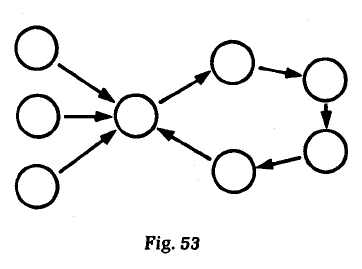
Here
we can see
how the different attributes
feed into
the collector point
of the concept.
From the concept
we then get
a loop
consisting of
all the fixed characteristics
of that concept.
It is fairly easy
to see
that the whole thing
is either
a guessing game
or circular.
If a creature
has all the attributes
of a dog
then we can call it a dog,
but doing so
will not provide anything
we do not know already.
If the creature
has only some of the attributes
then we can call it a dog
and it will now get the rest of the attributes.
This is a guessing game
because
we assume that a creature cannot have some of the attributes of a dog
and not the others —
just as a duckbilled platypus
has a bill like a duck
but has fur and four legs.
In practice
the process
is more as shown in fig. 54.
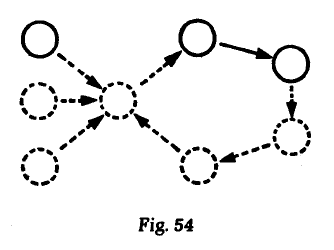
Here
the hints or clues
suggest
a hypothesis or guess.
This guess
is then checked out
by looking for
vital features.
If the check is passed
then the
concept description can be applied.
Lumping and Splitting
Science has always been a matter of
lumping together
into a single concept
things
which may seem different,
and separating
into two concepts
things
which seem the same.
Fig. 55 shows
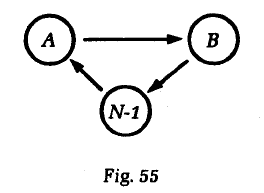
part of a flowscape
in which two collector points
are linked together
by a single name, N-1.
A scientist
now spots a vital
X factor.
One of the groups
has this X factor
and the other does not.
The flowscape
now splits into two,
as shown in fig. 56,
and this split is stabilized
by two new names, N-2 and N-3.
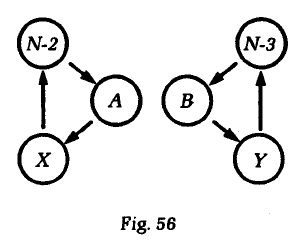
This process
of increased discrimination
happens all the time.
That is how different diseases
get identified
so that treatment
can be more specific.
The same process
can happen in reverse.
In Australia
there is a wealth
of brightly colored
parrots, parakeets, lorikeets etc.
Amongst all these
there is one bird
which is almost completely red
and another which is almost completely green.
For a long time
these were considered to be
two different species.
Then it was realized
that they were just
the male and female
of the same species.
This process of lumping is shown in fig. 57.
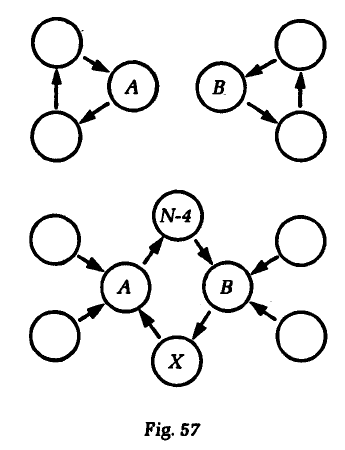
Two separate groupings
are united by a common feature
and the grouping is stabilized
with a new name N-4,
though it could retain one of the old names.
Concepts and Flexibility
There was a classic experiment
in which students were given
some electrical components
and asked to
make up a circuit
to ring a bell.
There was not
quite enough wire given
to complete the circuit.
Most students
gave up
and declared
that it was impossible.
A few
made use of the metal shaft
of the supplied screwdriver
to complete the circuit.
The majority of students
looked for
a 'piece of wire'.
The exceptional students
worked at a concept level
and looked for a 'piece of metal'.
The ability
to work at a concept level
is crucial for creativity
and for thinking in general.
As shown in fig. 58,
we need to keep moving constantly
from the actual detail level
to the concept level
and back again.
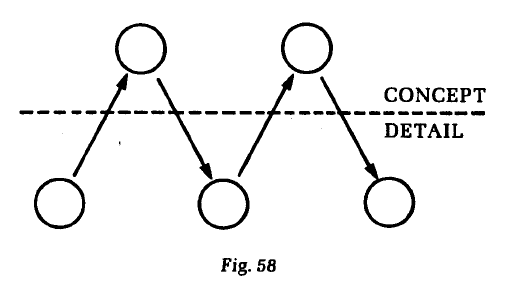
This is how
we move
from idea to idea.
This is the basis of
constructive thinking,
for otherwise
we are limited to experience
and what is before us at the moment.
Fig. 59 is an illustration of training.
You can train someone
to react to situation A with response 1,
to situation B with response 2,
and to situation C with response 3.
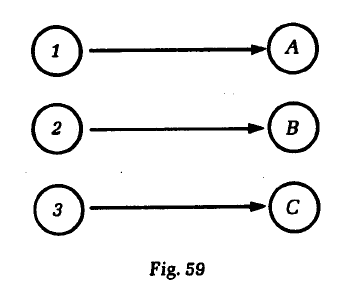
The training is effective
and these trained people
know what to do.
But if, one day,
situation A occurs
and response 1
is not possible
then that person will be lost.
But if the people
had been trained
using a function concept
to link
situation
and reaction
then that person
might have
looked around
and found
that another response
might also carry out that function concept, as shown in fig. 60.
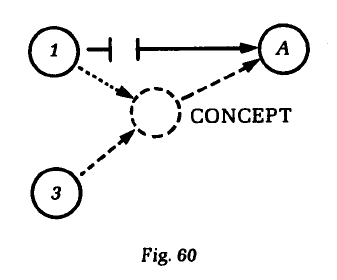
That is why
it might be limiting
to accelerate
the learning of young children.
They can be taught responses
but may lose out
on the development of concepts.
Pre-Concepts and Post-Concepts
Most concepts
are convenient package descriptions
after we know what is in the package.
The legal paragraph
used at the beginning of the section
defines the relevant properties precisely.
I call these
post-concepts
because they occur
after the event.
This packaging
for the sake of convenience
is shown in fig. 61,
which also indicates
how the concept is stabilized
by a name.
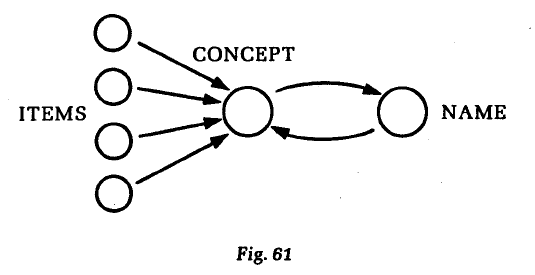
Sometimes,
however,
we start at exactly
the opposite end.
We know
what the concept should do
but we do not know
what the concept is.
Any writer knows this well,
as he or she searches
for just the right word
to describe
a complex set of features.
An engineer might say:
'At this point
we need something
that is going to change shape
and to form a shape
we have predetermined.'
The engineer knows
the features
of what is wanted.
The answer
could be a type of memory metal
which reverts back to a previous shape
at a given temperature.
Such metals are now in use.
The process is illustrated in fig. 62.
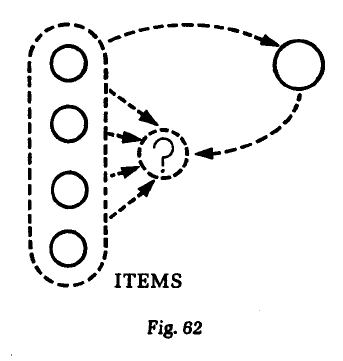
A pre-concept
is like defining a hole
and then looking for something
to fit that hole.
In a post-concept
we find the characteristics together
and name this cluster a concept.
In a pre-concept
we put together the characteristics
and then look around
for something to fit the defined need.
This is an important part
of problem solving.
A pre-concept
is a bit like a hypothesis
since it allows us to
move ahead of where we are at the moment.
I sometimes distinguish between
three types of question.
In a 'shooting question'
we know what we are aiming at
and the answer is 'yes' or 'no'.
This is a checking-out question.
In a 'fishing question'
we bait the hook
and wait to see what turns up.
This is an open-ended search for more information.
In a 'trapping question'
we prepare the trap
to suit
what we want to catch.
This is exactly the same as a pre-concept.
We define the needs
and then look for a way
of satisfying those needs.
Blurry Concepts
In most of our thinking
we are encouraged
to be precise.
This is very much
the nature of
rock logic.
In water logic,
however, the concern
is for movement:
where do we flow to?
There are times when
a blurry or vague concept
is actually more use
than a precise concept.
A blurry concept
can act as
a better collector point
and therefore
a better connector point.
Which is the more useful
of the following two statements?
'I need a match to light this fire'
or, 'I need "some way" of lighting this fire.'
In the first case
you look specifically
for a match
and if you do not find a match
you are blocked.
In the second case
your search
is much broader.
You might use a lighter,
you might take a light from a gas pilot light,
you might generate a spark,
and so on.
In an earlier book of mine
(Practical Thinking, London: Penguin, 1971),
I wrote about 'porridge words'
and the value of blurry concepts.
A precise concept
may fix where we are.
A blurry concept
allows us to move forward.
Once again,
this is partly related to the 'fuzzy logic'
that is now so fashionable
in the computer world.
Precision
often
locks us into the past,
what 'is'
and what has been.
Blurry concepts
open up
the future,
movement
and what might be.
A blurry concept
is not the same as
sloppy thinking.
A blurry concept
is definite
in its own way.
Working Backwards and the Concept Fan
One way to solve problems
is to work backwards.
This is not so easy to do
if we do not know
the solution to the problem.
If you want to reach point P
you can work backwards from that point
but if you are not sure where point P might be,
that is not easy.
There is, however,
a way of working backwards
that I have called.
The Concept Fan.
This is described
in more detail
in Serious Creativity
(New York and London: Harper Collins, 1992)
but I shall also mention it here
since it really depends on
the flow of water logic.
Suppose the purpose of our thinking
is to tackle the problem of
'Traffic congestion in cities'.
From that defined purpose
we work backwards.
What broad concepts
might help us
with that problem?
We might reduce the traffic load.
We might improve flow on the existing road system.
We might increase the available road surface.
Each of these
are broad concepts —
there may be more.
How might we
feed these
broad concepts?
This is the same notion
as the
feeding
of a collector point.
How might we reduce traffic?
We could encourage the use of vehicles with more people on board.
We could discourage drivers from coming into the city.
We could reduce the need for people to come into the city.
Again there will be other concepts which feed the broad concept of reducing traffic.
We would do the same
for each of the other
broad concepts.
Next
we see how
we could
feed these concepts.
In practice this means seeing how the concepts could be put into practical operation.
For example, how might we get vehicles with more people on board?
By
encouraging the use of public transport and making this better,
encouraging car pools and sharing, giving privilege lanes to vehicles with several occupants,
or by restricting central parking.
We do the same for each concept.
How might we
discourage drivers
from driving into the city?
By
charging a special fee for entrance before ten in the morning (as in Singapore),
making no provision for parking and using tough measures for illegal parking,
publicizing pollution levels in the city,
or by publicizing the actual rate of car movement in the city.
The process is shown schematically in fig. 63.
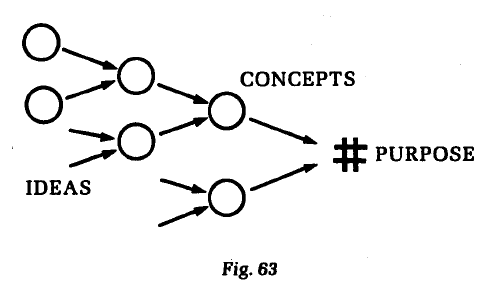
At the left-hand side
we end up with a number of practical ideas
which feed into the concepts,
which in turn feed into the broad concepts,
which in turn help with the problem.
The interesting point is
that our search is moving backwards
from the purpose (going from the right-hand side to the left-hand side)
but the flow path of achievement is flowing from the left-hand side to the right-hand side.
The process can be very powerful
if you are good
at putting down the different concepts.
This requires some practice.
The concept fan
is not an analysis of the situation
but an elaborated flowscape.
At times you may reach
a pre-concept
or a defined need
but not have a way of doing it.
For example, you might seek
to discourage drivers
by
'damaging their cars'.
Is it possible to find a way of doing this which would be effective but also acceptable?
Possibly not.
Concepts and Flow
This section of the book is important because
concepts
are a very important part of
flow
and water logic.
Concepts are collector points or junctions.
Concepts allow
things to come together.
Concepts allow
us to move across
from idea to idea.
Concepts allow
us to describe things
but also
to search for things (pre-concepts).
The better
you become
at using concepts
the better you will be
at water logic.
The question is always,
'Where does this take us?'
rather than, 'What is this?'
Context, Conditions and Circumstances
In water logic context is hugely important.
I have often used the landscape or river valley analogy to illustrate the flow patterns that form in the self-organizing information system we call the brain.
This analogy gives a good picture but has one major defect.
The landscape is fixed and permanent.
But in the brain
a change of context
can change the landscape.
It is as if
a different landscape
were being observed.
Under one context or set of circumstances
in the brain,
state A will be
succeeded by
(or flow to) state B.
But if the context changes
then A
will flow to C.
The context change
might be chemical.
A change in the chemicals
bathing the nerve cells (or released at nerve endings)
will lead to different sensitivities.
This is also explained in more detail
in the book I am Right - You are Wrong.
It seems likely
that changes in emotion
change
the biochemical balance
and so the flow patterns shift.
This is an essential part of the functioning of the brain
and not some ancient irrelevance.
Self-organizing patterning systems
need
emotions
in order to function well.
Fig. 72 shows a simple flow from A to B. With a context change the flow is from A to C.
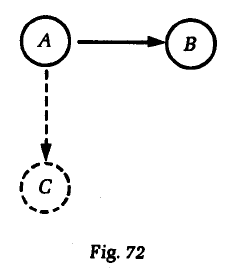
Other inputs into the brain
at the same time
will also alter the context
because
different nerve groupings will be activated
or partially activated (sub-threshold).
So
when the currently activated grouping (or state) tires,
then a different new grouping will follow.
For this reason
the basic water logic theorem
is stated as follows:
'Under conditions X,
state A will always
flow to state B.'
We can return briefly to the jellyfish.
Let us suppose
that at night
they disengage their stings
and sting another jellyfish.
There will therefore be
two arrangements:
the day arrangement
and the night arrangement.
The brain
behaves in the same way
but at a more complex level
because there are many possible contexts.
In an argument
people with opposing perceptions
are often both right.
Each of the opposing perceptions
is based on
a particular set of
circumstances and context.
The variability
may arise
in many ways.
Each party
is looking at
a different part
of the situation.
Each party
is looking at the same situation
but from a different point of view
(like different views of the same building).
The emotional setting is different.
Personal history and backgrounds are different.
Traditions and cultural backgrounds are different.
Immediate past history has created a different context for each of the parties.
It is characteristic of rock logic to ignore all this and to assume that the absolutes of 'truth' are independent of the current context.
Science only works because in any experiment it is assumed that the context is held constant while one factor (the experimental variable) is altered.
In some of the flowscape examples
I have mentioned
the huge importance
of context
and in one example
shown the effect of
a context change.
For most of the examples,
however,
it has been assumed
that the context is fixed.
Is this reasonable?
The flowscape method
deals with
the inner world of perception.
A flowscape
is not a description
of the outer world.
Whenever a flowscape is constructed
the person
laying out the stream of consciousness list
and making the flow connexions
has some definite context in mind
at that moment.
So for that moment
the context is fixed.
If that person
wishes deliberately
to change the context
then a different flowscape
can be laid out.
At a different time
a new flowscape
might be made
and might differ
from the original one
because the context is different.
For this reason
we do not put into a flowscape
the possibility that
state A can also flow to state C
under different circumstances.
That would not only be confusing
but would be incorrect
since it would
refer to a possible perception,
whereas flowscapes
are about actual perceptions
at this moment.
At the intervention stage
it is now possible
to speculate
on how perceptions might be changed
if a context
were to be changed.
Now we are
looking at possibilities.
It is always best
to construct a new flowscape
(or part of the flowscape)
rather than to attempt
to show the change
on the same flowscape.
This causes confusion
because you can always
add a new flow arrow
but you cannot remove an existing one.
The use of different colors is a help
but it is far better
to lay out a new flowscape
for the new context.
What about 'if' factors?
'If he were rich this would happen … but if he were poor then this would happen …'
'If the sun were shining then I would do this … if the sun were not shining I would do that …'
When you take a picture with a camera
the photograph tells you
what is there at that moment.
The photograph does not tell you what it would be like
'if' the sun were to come out,
if the man were thinner,
if the boy were to smile,
if the woman wore a green dress, etc.
In the same way
the flowscape is
a 'picture' of perception
at any one moment.
Where there is an interest in
an 'if' or possible context change
then do another flowscape
for that other context.
Creating Contexts
Quite often there are specific context conditions:
war conditions,
the context of intense jealousy,
if the sun is shining,
if he is rich,
etc.
These are definable contexts.
Most of the time, however, a context is not defined but is built up of many different factors:
experience,
prejudice,
culture,
the media,
etc.
At the beginning of the book I mentioned that one characteristic of water is that you could add water to water and still get just water — in contrast to adding rock to rock.
So we can build up contexts in layers.
We add further inputs one after the other.
The inputs do not have to be connected.
The inputs may be contradictory.
We just add them.
Gradually a context builds up.
Poetry and much of art is concerned with the build up of a mood, scene or understanding in this way.
There is no attempt to interconnect the elements or to make deductions: the mood just develops.
In the creative process,
people are often asked
to saturate their minds with information
and considerations about the subject
and then to let these settle down on their own.
In the book I am Right - You are Wrong the process is formalized as a 'stratal'.
This is different layers or strata which have no connection other than that they are about the same subject and are put down in the same place.
The result is very similar to blank verse or even a Japanese haiku.
There is no conclusion and there is no intention to make any point.
All this is sensible and reasonable behavior in a self-organizing system.
The inputs do organize themselves
to give an output
which we might call intuition.
More importantly
we build up a background context
in which our thinking
can take place.
In setting out to create a flowscape
it can be worthwhile
to establish the context in this way:
putting down layers of
statements and considerations.
This creates the context
in which the flowscape
is going to be set.
From this
also comes
the stream of consciousness list of points.
This preliminary stage
is a sort of sensitizing
of the mind
to the subject.
Accuracy and Value
If flow and water logic
are so heavily dependent on context
and if context can be so variable,
then how can a flowscape
ever
be accurate
or have a value?
Our actions
arise from our perceptions
and we do manage to
initiate and carry through sensible actions.
Perceptions are changeable
but are also stable enough
to give us
actions and flowscapes.
If I asked you to
arrange the numbers 3 5 2 4 1 6 from the smallest to the biggest,
you would have little difficulty in putting down 1 2 3 4 5 6.
If I asked you to
arrange the numbers 2 13 8 20 3 9 from the smallest to the biggest,
you would not tell me that it is impossible because all the numbers are not there.
You would arrange them quite simply: 2 3 8 9 13 20.
In the same way
a flowscape
does not have to be comprehensive
to have value.
We arrange
what we have
and then see what we get
'Accuracy' is a term which comes directly from rock logic.
Is the flowscape
an accurate reflection
of the perception of the person
making the flowscape?
If it is made honestly
then it will be a reflection
of that person's perception —
because it is made with perception.
If the person puts down
what he or she 'thinks they ought to think'
then that is the picture that will emerge.
The value of a flowscape
is that it allows us to
look at
our perceptions.
We can
agree with them
or disagree with them.
We may get
insights
and also a sense of relative importance
and controlling factors.
We may observe
how the perceptions might be changed.
We may get ideas or approaches
for acting in the outer world
represented by the flowscape
of the inner world.
All these things are values.
Could we end up fooling ourselves?
The answer is certainly 'yes' because we are very good at that.
But we have a much better chance of detecting the self-deception with a flowscape than without it.
Flowscapes do not have
a 'proving value' as in rock logic.
Their value is illustrative and suggestive.
A flowscape provides
a framework
or hypothesis
for looking at the world.
A flowscape provides a tangible way of getting to work on our perceptions.
Do not set out to construct the 'correct' flowscape.
Put down the stream of consciousness list
and then work forward from that
and see what emerges.
Then look at that.
Attention Flow
Related: How to Be More Interesting
You are walking through long grass and suddenly you hear a rustle right behind you.
Your attention switches to that rustle.
You are examining a piece of jewelry and the assistant puts another piece in front of you.
Your attention switches to the new piece.
You are talking to someone at a cocktail party and suddenly one of her earrings falls off.
Your attention switches to that.
It is hardly surprising that
if something new turns up
your attention may be caught by that.
But what about those situations where there is nothing new?
How then
does attention
shift or flow?
You can live in a house for years and not notice some feature until a guest points it out.
The Boy Scouts have a game, called, I believe, Kim's Game, in which you are presented with a tray of objects which is then removed after a few moments.
You try to recall as many objects as you can.
Noticing things is certainly not easy and may require a lot of training.
Medical students are taught to notice all sorts of features of a patient in order to help with the diagnosis.
Conan Doyle applied his medical training in this respect to the behavior of his detective character, Sherlock Holmes.
There is a sort of paradox in that
the mind is
extremely good at recognizing things
and yet poor at noticing things.
From a tiny fraction of a familiar picture someone will recognize the picture.
From a single bar someone will recognize a musical piece.
Perhaps there is no paradox at all.
We notice the familiar things we are prepared to notice.
At the same time very unusual things will catch our attention.
Anything in between is unlikely to be noticed.
This is not at all a bad design for a living creature to make its way through life.
In many amusement parks today there are long water chutes in which a little water running down a chute provides enough slipperiness for a child to slide down the entire chute.
The surface has to be very smooth.
Imagine the trouble that would be caused by a protruding bolt.
There is the same effect when something interferes with the smooth flow of attention.
The opposite of interruption is the smooth flow that contributes to aesthetics.
In a way art is a choreography of attention,
leading attention first here
and then there.
The same is true of the art of a good storyteller.
There is
background
and foreground
and loops of attention.
You look at a beautiful Georgian house set amongst trees.
At first you look at the whole setting.
Then your attention moves to the house itself.
Then to the portico or main door.
Then back to the house.
Then to an individual window.
It is this dance of attention that gives us the feeling of pleasure.
It is probably true that there are
certain things
that the human mind
finds intrinsically attractive.
There are certain proportions
which may or may not
reflect the proportions
of a mother's face
to an infant.
There are certain rhythms
which may or may not be
related to the effect
of the mother's heartbeat
upon a child.
The rest may be
the rhythm of
the flow of attention.
In a sense
all art
is a sort of music.
We often think of attention
as a person holding a torch
and directing the beam
at one thing after another.
This does happen sometimes.
If you attend very formal art appreciation classes
you may be given
a sort of check-list of attention.
Notice the use of light and shade.
Notice the disposition of the figures.
Notice the use of color.
Notice the brushwork.
Notice the faces, etc.
Here, attention is flowing along a preset pattern
in order to
notice things in the world in front.
Mostly, however, there are no check-lists
except those
set by familiarity and expectation.
Mostly attention flows
according to
the rules of water logic.
If the flow of attention
turns up something interesting
then there is a new direction,
and new loops form.
You might be looking
at the carving on a Hindu temple
and suddenly notice a swastika sign.
Because of the association of
the swastika with Nazi Germany
your attention is caught
and loops around in that area.
You may wonder
what the sign is doing there
if you do not know
that it is indeed
an ancient Hindu symbol.
So the attention flow itself
can turn up things
which develop
further attention flows.
Drucker and de Bono topics
You are looking at something in a museum
and then you read the label —
this prompts you to notice things
you have not noticed.
So even if
there are no new events,
attention can turn up 'new events'.
If attention follows the rules of water logic
then why does attention
not lock itself
into a stable pattern
and stay there?
To some extent
this is what attention
normally does.
Most of the time
we recognize things
and do not give them a second glance,
precisely because
we have locked into
the usual stable pattern.
At other times
the flow of attention
uncovers new things
which then
develop new loops.
Any new input
will change the context
and so
get us out of a stabilized loop.
Attention flow
may uncover
areas of
richness
and detail.
The immense richness
of the carvings on a Hindu temple
makes it difficult for us to see it
as a whole.
In contrast, the attention flow of the Taj Mahal
is an excellent example of
a smooth flow
from the whole
to a part
and back to the whole
and back to another part,
and so on.
If there is too much detail
we get bogged down.
If there is too little detail
we can only see the whole,
and attention does not flow —
as in some modern buildings.
Somewhere between
too much and too little detail
is the richness of the Gothic style.
This is more like
the intricacies of a morris dance
rather than the waltz of the classical style,
although that could also have
many intricacies.
The difference between
perception which is purely internal
and attention flow which is directed outwards
is that attention
can trigger new perceptions.
This can also happen in
the inner world of reflective perception
but is much more rare.
In general, in reflective perception,
it is a matter of existing perceptions
which organize themselves into flow patterns
which we attempt to capture with flowscapes.
If a dog is taken on a walk
then the dog will
stop,
sniff around
and explore one area
then set off for another area,
which is then explored again, and so on.
Attention flow is somewhat like that.
Fig. 76 shows that the overall track of attention flow is really made up of several exploratory loops on the way.
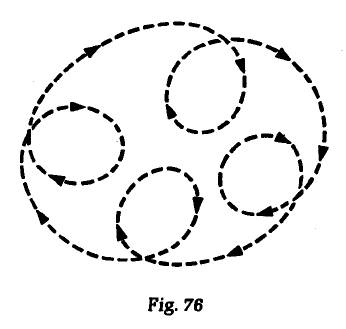
If we include the loops
in the overall track
then fig. 77
shows some possible
attention-flow tracks.
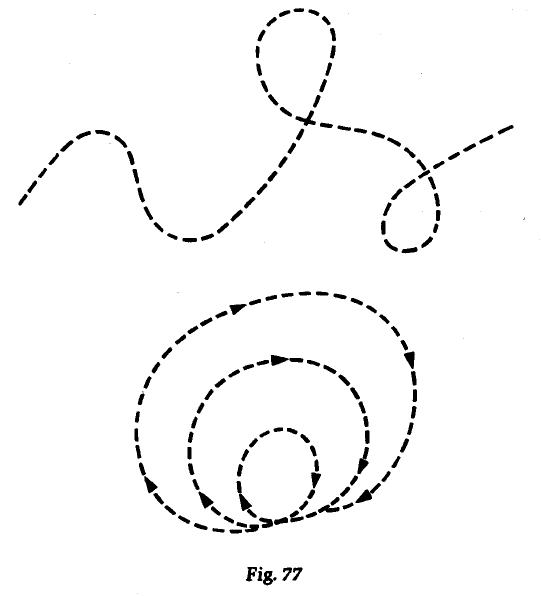
In one case
the track just wanders about.
In another case
the track keeps coming back
to the starting point
but then moves out
in widening circles,
all of which still come back to the start.
In another case
the loops succeed each other
but the whole returns full circle
to the starting point.
I suspect
the attention flows
that complete the circles
are the ones
which we would
find most appealing.
'Isness'
Indian philosophies put a lot of emphasis on 'isness'
which means
really seeing
what something 'is'.
If you sit and contemplate a rose for three hours
you will begin to see a 'rose'.
Mostly attention has a practical job to do:
explore a matter
until you
recognize it
and then move on.
Once the perceptual loop
has stabilized
we move on.
So we do not really see a rose
but just the usual impression
of a rose.
Meditation is an attempt
to halt the flow of attention
and to unravel
the stable perceptual loops.
One can ascribe metaphysical value to that
as you wish.
A somewhat similar effect
can be obtained with drugs
that interfere with
the normal nerve coordination,
so making familiar things look strange
because the established flow patterns
no longer work.
Tension
Salvador Dali's famous painting
of the melting watch
is a pure example of
the use of the tension
between two opposing patterns:
the rigidity of a watch
that is necessary for it to perform
its function of accuracy,
and the soft contours of wax-like melting.
The mixing,
opposing
and juxtaposing of images
has an extensive tradition in art.
It is unusual,
it catches our attention
and makes us stop,
think
and perceive anew.
Without claiming that it is easy to do this well,
it can be said
that this is a relatively simple technique
used also by bad artists
and bad poets
to achieve effect.
To talk about the 'cold fire of his spirit'
creates a perceptual tension
between
the normal perception of fire as hot
and the attachment of the image of 'cold'.
The mind does not quite know how to
settle down
and oscillates
between the two images,
creating an effect
more powerful than
'the fire of his spirit'.
There is genuine descriptive value
in that the 'cold fire'
does suggest
a passion that is
cold,
calculating
and ruthless.
A significant part of art
is based on
the need
to unsettle the usual.
Normally
attention does its work
and moves on.
Attention flow
is normally dismissive.
Art
seeks
to highlight,
to deepen perception
and to open up insights.
This is done
by disrupting patterns,
by juxtaposing patterns,
by providing new pattern frameworks.
If attention were a cook
it would always
contentedly cook
the same dishes.
By
interfering with the cooking,
by providing new ingredients,
by removing staple ingredients,
art sets out to
re-excite our taste buds
with new dishes
that allow us to
taste the old ingredients anew.
When the Impressionists
first started
to show their work
it was judged
hideous and ugly
by most of the
art critics and connoisseurs.
This was because it was 'ugly'
when viewed through
the frames of expectation
of existing and traditional painting.
People had to be trained
to look at the paintings
in a different way
to appreciate their beauty.
Carrying this to an extreme,
if you put a pile of bricks
into an art gallery
and you ask people
to look at the bricks
as a work of art
then they really do become a work of art.
This circles back to
the 'isness' I mentioned before.
Our normal perception patterns
treat bricks as mundane building materials
but if we break that loop
we see them differently
but still keep a faint echo
of their constructive value.
Triggering
A finger on a trigger
can release
a child's pop gun
or a nuclear bomb.
There is no direct relationship
between
the pressure on the trigger
and the effect.
A system is set 'to go'
and you trigger it to go.
Perception
has already set up
the patterns
which are ready to go.
The triggers or stimulation
we receive
from the world around
set off flow patterns
in the brain
which settle down
into the standard perception.
It is something like
those children's play books
in which the child
is asked
to join up the given dots.
The patterns
that we operate as perception
depend upon the triggers received,
past experience
and the organizing behavior of the brain.
It is this organizing behavior
that has been the subject
of this book.
This behavior involves
the formation of
temporarily stable states
which tire
and are succeeded by
other similar states
in the flow of water logic.
This flow itself
stabilizes as a loop
and that forms
the standard perception.
Attention flow
is determined by
the outer world
and also by the standard perception patterns
which direct where we should look
in order to check out
the suitability of the patterns.
It is very similar to a conversation.
In a conversation
you listen to what is being said
but your own mind
is going about its own business.
So we pay attention
to what is out there
but our own brain is busy
with its perception patterns and flows.
Just as the leaves of a tree
all 'flow' down the branches
into the tree trunk
so the different sensations
are 'drained' into
an established flow pattern.
Directing Attention
Attention flow
is determined by
what is out there,
our standard perceptual patterns,
the context of the moment
and
what we may be trying to do.
Is this natural flow of attention
the most beneficial or effective?
It may be effective for
long-term survival of the species:
do not waste energy on
what you already know
and what is not valuable at the moment.
But it is less than effective for other matters.
The whole purpose of a university education
is supposed to be to train the mind
to probe more deeply —
and this requires
attention-directing practice.
The formal checklist
for art appreciation
that I gave earlier
is a simple example
of attention directing.
It may seem rigid and mechanical
but in time
it does result in
better attention flows.
The very first lesson
in the CoRT thinking program for teaching thinking as a school subject
has a simple attention-directing device called
the PMI.
The student directs his or her attention to
the Plus aspects of the situation,
then the Minus aspects
and finally the Interesting aspects.
If people do this anyway,
as some claim,
then the exercise
should make no difference.
Instead
we get huge differences
in final judgement
(from 30 out of 30 students being in favor of an idea to only one being in favor).
There is no mystery.
The normal attention flow results in
an immediate emotional reaction
which then determines an attention flow
to support that reaction.
The PMI ensures
a basic exploration of the subject
before judgement.
This is not at all natural.
What is natural is to
interpret,
recognize
and judge
as quickly as possible.
That has long-term survival value.
The flowscapes
put forward in this book
are attention-directing devices
in the sense that
the examination of a flowscape
can direct our attention
to the significant parts
of our own perception.
Errors
Can there be misleading errors in a flowscape?
Since a flowscape does not claim to be right it is difficult for it to be wrong.
A flowscape is a hypothesis or a suggestion.
It is a provisional way of looking at the shape of our perceptions.
If we do not like what we see
then we can check out
what it is that we do not like.
When we get a surprise,
we may find it is the surprise of insight:
'I did not realize that point was as central as it is.'
Since most of the attention
is on
collector points and stable loops,
there is a danger
that an important point
which just happens to feed into a collector point
will not get the attention it deserves.
In a way this is
as it should be
because collector points and loops
do dominate perception.
We usually believe that
important points
should dominate perception
but very often
they do not.
A flowscape
is a picture of perception
as it is,
not as it should be
There is a danger
of constructing a false flowscape,
which is one
which is carefully contrived
to give you the perception
you think you ought to have.
In such cases
you are cheating no one
but yourself.
There is no limit
to the number of flowscapes
you can lay out
on any subject.
You may
vary the connexions
and make another flowscape.
You can alter
some of the items
on the base list
and make a further flowscape.
Examine them all
and see
what you can get
from them.
When you attempt to
make flowscapes
for other people
you may be totally in error.
You have to keep that in mind.
Your perception
of another person's perception
may leave out something vital.
If the perception can be checked out
in some way
then that should be done.
If not,
then design strategies
which fit various possibilities.
Or just accept the risk
that you may have got it wrong
and go ahead with your strategy,
but be prepared
to change the strategy
if it does not seem to be working.

16. Summary
Our traditional rock logic is based on ‘is’
which leads us on to
‘identity’,
‘truth’,
‘contradiction’
and ‘logic’.
Mathematics is based on the ‘equals’ sign
which allows us to
operate
the rules of the game
of the mathematical universe.
Water logic is based on ‘to’
and the concept of ‘flow’.
In certain systems
flow
leads to ‘stable loops’.
A stable loop
is not the same as ‘truth’ —
it is a stable loop
which we can learn to use
just as we learned to use truth.
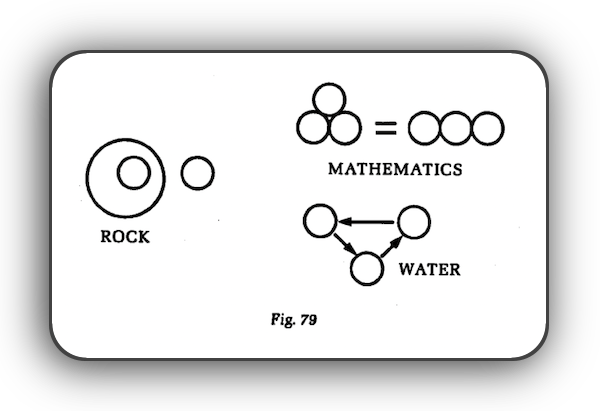
Fig. 79 shows the symbolic difference
between the three systems of
rock logic,
mathematics
and water logic.
This is obviously an oversimplification but it does make the difference clear.
It is actually very difficult for us to
think in terms of water logic
because language itself
and our habits of thinking
are so thoroughly based on rock logic.
We can just about be concerned with
pragmatism
and what things lead ‘to’
but our reasoning
is still based on rock logic,
and we keep coming back to it with such remarks as,
‘Is this right?’
As I wrote at the beginning, the book is actually very simple.
I have tried to keep it simple in order to provide a practical introduction to water logic.
I have wanted to provide a method that people can use for themselves instead of just reading about it.
There is far more to water logic
than I have covered in this book
but I have not wanted to
deter readers with complexity.
I hope to be able to take the matter further in later works.
There are two base theorems, both of which are simple:
1. In any system with a finite number of states and a tiring factor, a stable loop will always be established from any input.
2. Under a given context X, A will always lead to B.
In the book, I have examined
how the nerve circuits
in the brain
act as a self-organizing system
to allow perceptions
to arrange themselves
into stable states.
There is no mystery in this.
It is simple, fundamental behavior
of self-organizing systems
and well within the capability
of what we know about nerve circuits.
Although simple, this behavior is extremely powerful.
I explore this behavior in more detail in another book, I am Right - You are Wrong, to which I have made reference as appropriate.
This sort of thinking is now mainstream thinking amongst many working on brain behavior — although it was far from mainstream when I wrote about it in 1969 in The Mechanism of Mind.
I am not interested in merely analyzing and describing the behavior of the brain, nor am I especially interested in designing computers that think like the brain does.
But I am interested in ways of improving human thinking.
So there is a practical side to the book.
This practical side is the flowscape.
This technique is described in detail with many examples.
The laying out of a flowscape is very straightforward.
There is the stream of consciousness or base list.
Flow connexions are made for each item on the base list.
The result is displayed graphically.
We can now get to see the ‘shape’ of our perceptions.
Perceptions are highly individual, so there is no matter of saying this is right or wrong, unless you are guessing at the perception of some other person.
The flowscape is a hypothesis which we look at in order to examine our perceptions.
From such an examination we may come to see the collector points or sinks which draw other points towards them.
Such collector points tend to dominate any perception.
Then there are the stable loops which stabilize perceptions.
We may get
some understanding of our perception
and even some insights into what is going on.
We may come to realize
that some points are more important
and others less important than we thought.
We can
try to intervene
and see how our perceptions
might be altered.
Although we are intervening in the inner world of perception
we can get suggestions
that may also be useful
for intervening in the outer world.
So
we can devise strategies
based on flowscapes.
Such strategies
are suggested by the flowscape
but must be proved in other ways.
This is the same
as with any hypothesis.
We can set out to
make flowscapes for
other people.
This can be done
through discussion
as with a group.
It can also be done
by examining the
writing
or utterances
of the other person.
Finally we can attempt to
make a flowscape
for another person
by guessing.
Such flowscapes can suggest
strategies and actions.
In the book I write about
the huge importance of
concepts for water logic.
It is concepts
that give
movement
and flexibility
in thinking.
Such concepts
do not always need to be precise
because we are using water logic
rather than rock logic,
which depends on precision.
If we do not develop
a facility for
dealing with concepts
then we are locked into
the literal details of experience.
Concepts are also important
for the base list
of the flowscape.
Context is hugely important
in the flow
of water logic.
If the context is different
then the flow connexions
are different.
Any indication of flow
should always specify the context.
Although context is so very important
this does not complicate the flowscape
provided this is done at one moment in time.
The context of that moment
will affect the whole flowscape,
which becomes a picture of perception
at that moment.
Most disagreements
are really based on
differences of context.
Yet we usually direct our thinking
to arguing about
differences of ‘truth’.
Towards the end of the book
I write about attention flow
and also its relevance
to aesthetics and art.
Attention flow
is partly determined by
what is out there,
partly by
the perceptual patterns of our inner world
and partly by
specific attention-directing patterns
that we have developed deliberately.
There is a close connexion
between
perceptual patterns
and attention flow.
The world outside
triggers
the patterns that we then use
to ‘see’ the world outside.
Like much else
this matter
deserves much fuller attention.
I have set out to achieve three things:
1. An introduction to water logic.
2. An explanation of
how
the water logic
of perception
is based on
the self-organizing nature
of the nerve circuits
in the brain.
3. A practical technique
to make visible
the flow patterns of our perception so that we can see the ‘shape’ of our thinking.
This is the flowscape technique.
The flowscape technique
can be used in its own right
even if you do not
accept, or understand,
the basis for it.
The purpose of any conceptual model
is to provide something
useful and usable.
That itself is an example of water logic:
‘What does this lead to?’
I am aware that the rigidities of rock logic
will make some people
uncomfortable with this book.
At the same time
there are many
who will welcome the fluidity
of water logic
because such people have always felt that rock logic
is totally inappropriate and inadequate
to deal with perceptions.
And perceptions are extremely important.

The Backstory: My brother is one of millions who won’t get the COVID-19 vaccine.
Source
I asked why.
Here are his reasons, my responses.
I’m USA TODAY editor-in-chief Nicole Carroll, and this is The Backstory, insights into our biggest stories of the week.
If you’d like to get The Backstory in your inbox every week, sign up here.
Today, our front page encourages people to get the COVID-19 vaccine.
I agree completely with the message because overwhelming evidence shows vaccines save lives, but wonder if it will make a difference.
Those against the shot are adamant in their beliefs.
One of them is my brother.
About 2,000 people a week in the US are dying from COVID-19, mostly infected by the fast-spreading delta variant, according to a USA TODAY analysis of Johns Hopkins University data.
About 99% of deaths today are people who did not get vaccinated.
Patients dying in hospitals are telling loved ones they regret not getting the vaccine.
Given the dire situation, I wanted to know what is keeping so many from getting vaccinated.
So I asked my brother, why won’t you get a vaccine?
It’s a conversation many family members are having (or need to have).
First of all, he doesn’t trust it.
He’s worried about long-term effects years down the road.
I pointed out that all three US vaccines went through rigorous clinical trials.
Moderna was tested on 30,000 people, Pfizer on nearly 44,000, Johnson and Johnson on more than 39,000.
Side effects, including pain at the injection site, headache, fatigue and nausea, were mild to moderate and resolved within a few days.
And since then, about 165 million Americans (about 50%) have been fully vaccinated.
Long-term side effects “are extremely unlikely,” according to the CDC, because historically vaccine monitoring has shown side effects appear within six weeks.
A study out Wednesday,published by JAMA, showed that for every 1 million Americans vaccinated against COVID-19, only 60 developed heart problems.
Complications were short-lived.
My brother, Chris Carroll, also says fully vaccinated people are getting breakthrough viruses, so why bother.
The vaccinated can get COVID.
Sen. Lindsey Graham announced this week he tested positive despite being vaccinated.
But, as Graham pointed out, those with the vaccine generally have mild cases and are far less likely to die than the unvaccinated.
Fully vaccinated people made up nearly three-quarters of COVID-19 infections after Fourth of July events in Provincetown, Massachusetts.
CDC director Dr. Rochelle Walensky said in a statement the findings “raised concern that, unlike with other variants, vaccinated people infected with delta can transmit the virus.”
But experts agree the outbreak, where seven were hospitalized and no one died, could have been much worse without vaccines.
And breakthrough infections overall are rare.
A Kaiser Family Foundation analysis of data available from 23 states and Washington, D.C., found the rate of breakthrough cases among the fully vaccinated was below 1% in each state.
More than nine in 10 COVID-19 cases, hospitalizations and deaths were in people either not vaccinated or not fully vaccinated.
My brother says he’s also cautious because the vaccines had only emergency FDA authorization.
Full authorization for Pfizer could come as soon as next month.
I asked him if that would change his mind.
Not really, he said, as the FDA is a government organization, and maybe President Joe Biden pressured them to approve it.
“He’s going overboard trying to sell it,” Chris said.
“Because Biden wants me to get it so bad, that makes me skeptical of getting it.”
So does politics play into his decision not to get a vaccine?
Absolutely, he says.
He doesn’t trust the president.
But the vaccine was developed under President Donald Trump, I pointed out.
“He was under pressure” to get a vaccine quickly to reopen the economy, Chris replied.
Chris is a Christian conservative and lifelong Texan.
He’s bothered by the pressure to get what he calls “the jab,” such as lotteries, financial incentives, employer mandates.
Will these types of mandates encourage him to get the vaccine?
“No.”
He had COVID-19 late last year, and while there are people now sick for a second time, he isn’t worried about getting it again.
He said blood tests have confirmed he has COVID antibodies, and he feels comfortable with his natural immunity.
However, it’s not known exactly how long antibodies from infection last or how mutations of the virus may impact that.
Research published Feb. 5 in Science magazine found natural immunity can last at least eight months.
More recent research, published May 24 in Nature, detected cells producing coronavirus antibodies in patients at least 11 months after they had mild COVID-19 cases.
Chris doesn’t look down on those who get the vaccine.
He thinks vaccines are purely a personal choice.
“I believe in individual liberty,” he said.
“We should be able to decide if we want something put in us.”
But what happens when individual liberty begins to harm the common good?
For example, unvaccinated people can keep the virus spreading to those unable to get vaccines, like kids or those with weakened immune systems.
Does he worry his individual decision can harm others?
“Government does have a role to play in community safety,” he said.
“We should have a police force, a military to protect people, food and water safety.
But that’s a bit different than requiring the masses to take something.”
And what about those who can’t get vaccinated, like kids, shouldn’t we protect them?
“How many kids were killed in car accidents versus kids killed by COVID,” he asked.
“Should I be out there driving?
There is always some risk.
I feel more at risk by driving my car around.
“I don’t want to see any kids die; I’ve actually had a child who died.
If I believed me taking this vaccine would stop kids from dying, I would take it.”
Medical experts agree that vaccines and masking can help control the spread of the virus, including to kids.
In 2019, 612 children younger than 13 died in motor vehicle traffic crashes and more than 97,000 were injured.
The American Academy of Pediatrics said that as of July 29, almost 4.2 million children have tested positive for the virus, nearly 72,000 of them in the last week.
That’s almost twice as many as the 39,000 infections from the previous week.
Since May 2020, more than 17,000 kids have been hospitalized with COVID-19; 358 have died.
Two children with COVID-19 died over the weekend in Tennessee, according to Le Bonheur Children’s Hospital.
“It’s important for everyone to know that we’re seeing sicker kids, we’re seeing more kids be admitted that are sick with actual COVID illness, and that those kids, some of them are in our intensive care unit and some of them are intubated,” Le Bonheur’s Dr. Nick Hysmith, a pediatric infectious disease specialist, told Memphis Commercial Appeal reporter Laura Testino.
Also, experts have said the longer the virus spreads, the more likely it can mutate and come back into the entire population, making vaccines less effective, endangering lives again.
My brother says he’s not sure that’s true.
On Tuesday, the CDC’s Walensky said it is, telling reporters, “For the amount of virus circulating in this country right now largely among unvaccinated people, the largest concern that we in public health and science are worried about is that the virus …(becomes) a very transmissible virus that has the potential to evade our vaccines in terms of how it protects us from severe disease and death.”
Still, he said, “How many things have they been wrong on?”
And that, in the end, is his biggest problem.
Trust.
“It’s hard to believe anything,” he said.
“There is so much information out there, and so much bad information out there.
There is so much distrust.
For me, I try to read everything I can, pray for wisdom, and make the choice I feel is best for myself and my family.”
So, back to my first question.
Can professional journalists make a difference?
We’re giving it everything we have.
We are fact checking statements in the news, giving you original sources so you can see the evidence for yourself.
Our expert health reporters followed the trials carefully, watchdogging the process and the results.
And we’ve got reporters across the country reporting first-hand what is going on in different communities, talking to health care workers, COVID patients, grieving families, stressed out parents.
There is no higher calling in journalism than to give people accurate information to help them make decisions that can save lives.
“We don’t know what to believe,” my brother said.
“We don’t know who to trust.”
We know that trust is earned.
We work to earn your trust with every story, every day.
Nicole Carroll is the editor-in-chief of USA TODAY.
Reach her at EIC@usatoday.com or follow her on Twitter here.
Thank you for supporting our journalism.
Originally Published 5:02 a.m. EDT Aug. 6, 2021
**Updated 12:06 p.m. EDT Aug. 6, 2021**

|
![]()
